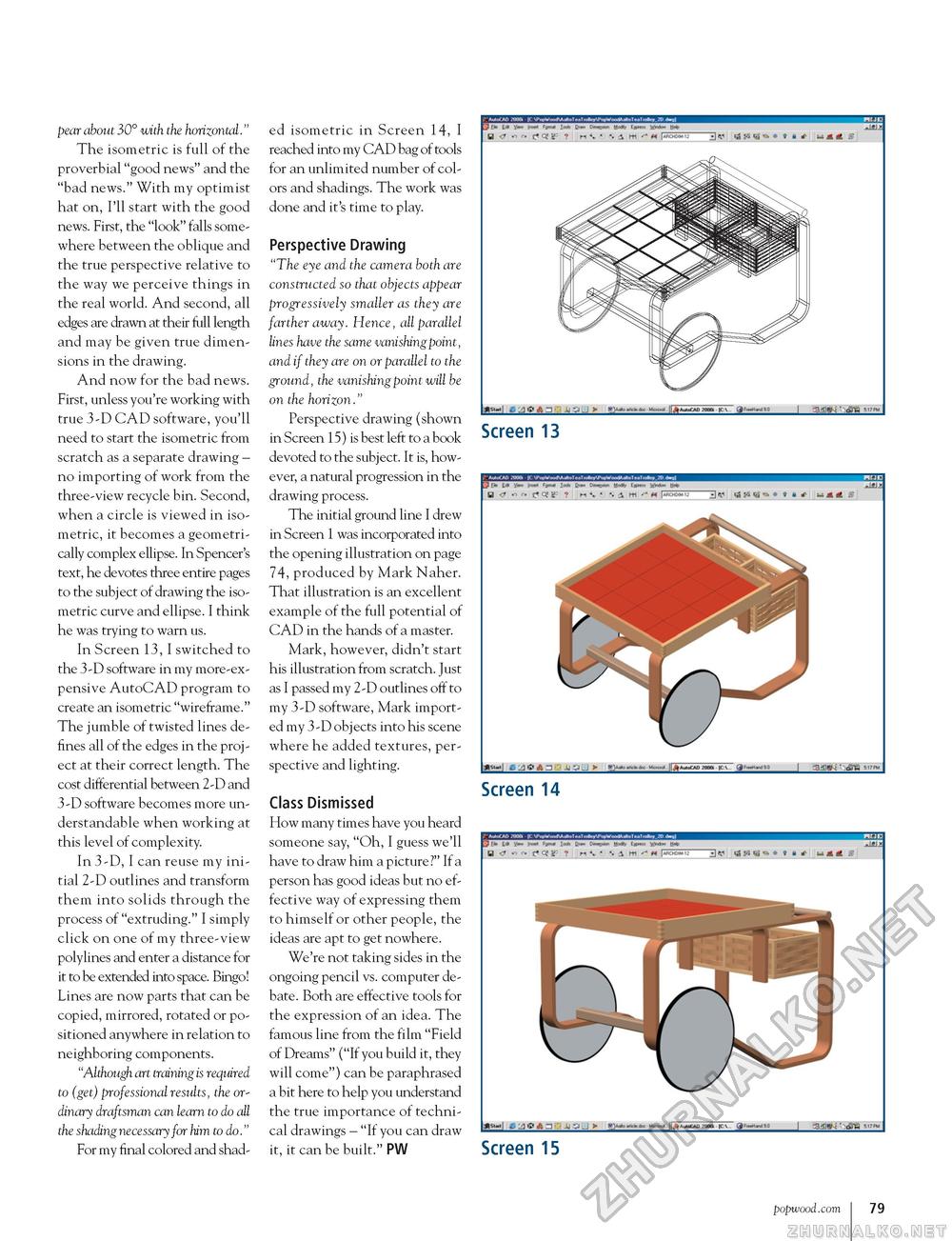Popular Woodworking 2004-04 № 140, страница 81
pear about 30° with the horizontal." The isometric is full of the proverbial "good news" and the "bad news." With my optimist hat on, I'll start with the good news. First, the "look" falls somewhere between the oblique and the true perspective relative to the way we perceive things in the real world. And second, all edges are drawn at their full length and may be given true dimensions in the drawing. And now for the bad news. First, unless you're working with true 3-D CAD software, you'll need to start the isometric from scratch as a separate drawing -no importing of work from the three-view recycle bin. Second, when a circle is viewed in isometric, it becomes a geometrically complex ellipse. In Spencer's text, he devotes three entire pages to the subject of drawing the isometric curve and ellipse. I think he was trying to warn us. In Screen 13, I switched to the 3-D software in my more-expensive AutoCAD program to create an isometric "wireframe." The jumble of twisted lines defines all of the edges in the project at their correct length. The cost differential between 2-D and 3-D software becomes more understandable when working at this level of complexity. In 3-D, I can reuse my initial 2-D outlines and transform them into solids through the process of "extruding." I simply click on one of my three-view polylines and enter a distance for it to be extended into space. Bingo! Lines are now parts that can be copied, mirrored, rotated or positioned anywhere in relation to neighboring components. "Although art training is required to (get) professional results, the ordinary draftsman can learn to do all the shading necessary for him to do." For my final colored and shad- ed isometric in Screen 14, I reached into my CAD bag of tools for an unlimited number of colors and shadings. The work was done and it's time to play. Perspective Drawing "The eye and the camera both are constructed so that objects appear progressively smaller as they are farther away. Hence, all parallel lines have the same vanishing point, and if they are on or parallel to the ground, the vanishing point will be on the horizon." Perspective drawing (shown in Screen 15) is best left to a book devoted to the subject. It is, however, a natural progression in the drawing process. The initial ground line I drew in Screen 1 was incorporated into the opening illustration on page 74, produced by Mark Naher. That illustration is an excellent example of the full potential of CAD in the hands of a master. Mark, however, didn't start his illustration from scratch. Just as I passed my 2-D outlines off to my 3-D software, Mark imported my 3-D objects into his scene where he added textures, perspective and lighting. Class Dismissed How many times have you heard someone say, "Oh, I guess we'll have to draw him a picture?" If a person has good ideas but no effective way of expressing them to himself or other people, the ideas are apt to get nowhere. We're not taking sides in the ongoing pencil vs. computer debate. Both are effective tools for the expression of an idea. The famous line from the film "Field of Dreams" ("If you build it, they will come") can be paraphrased a bit here to help you understand the true importance of technical drawings - "If you can draw it, it can be built." PW Screen 13 Screen 14 Screen 15 popwood.com 79 |








